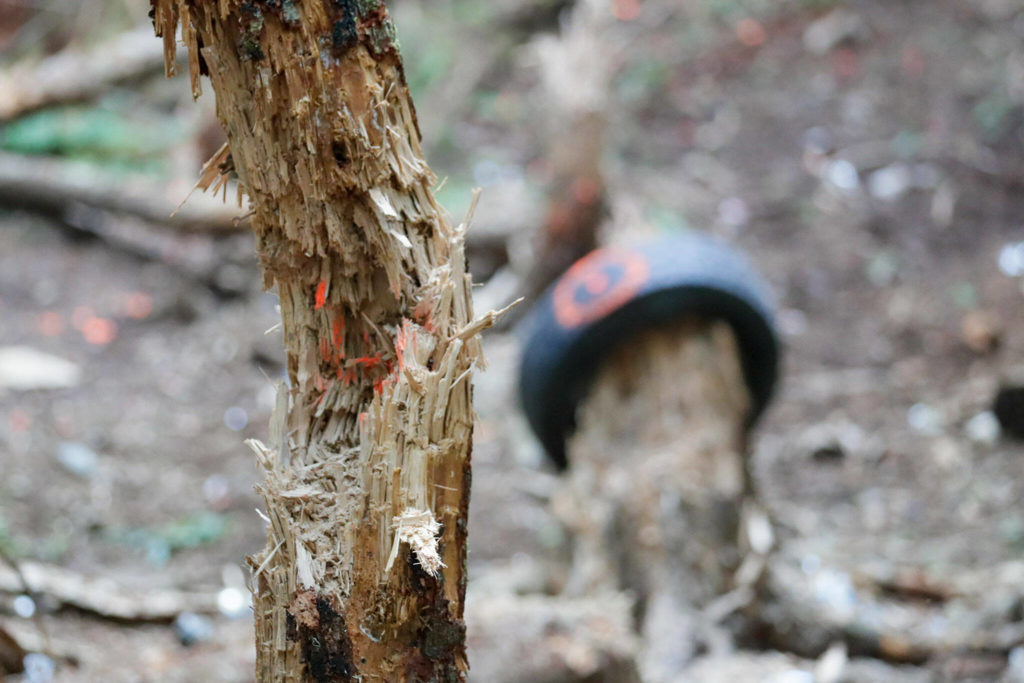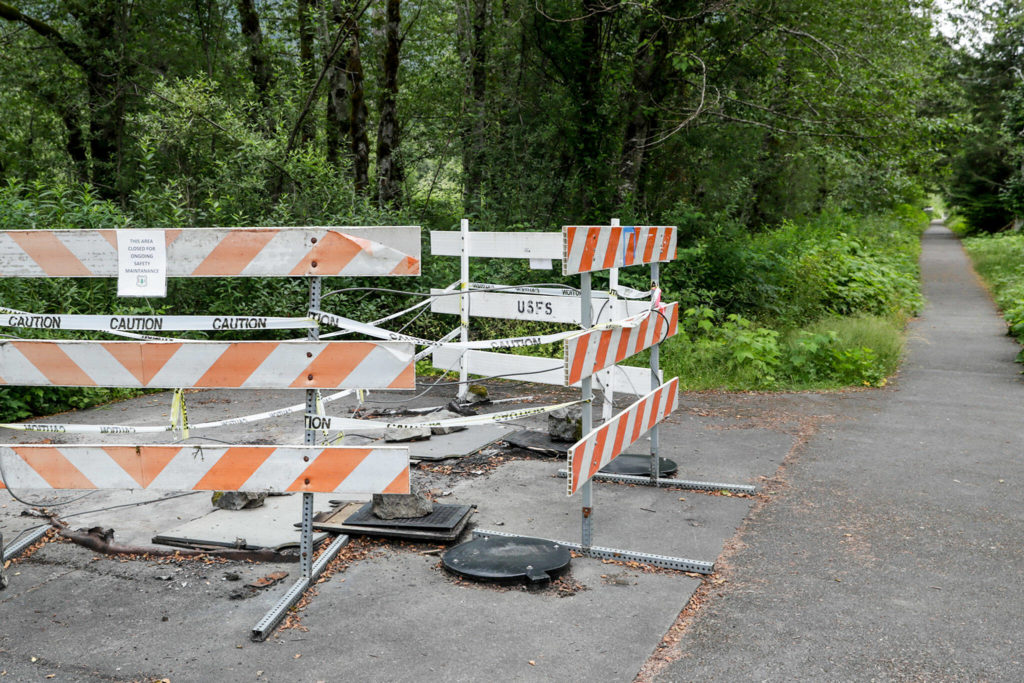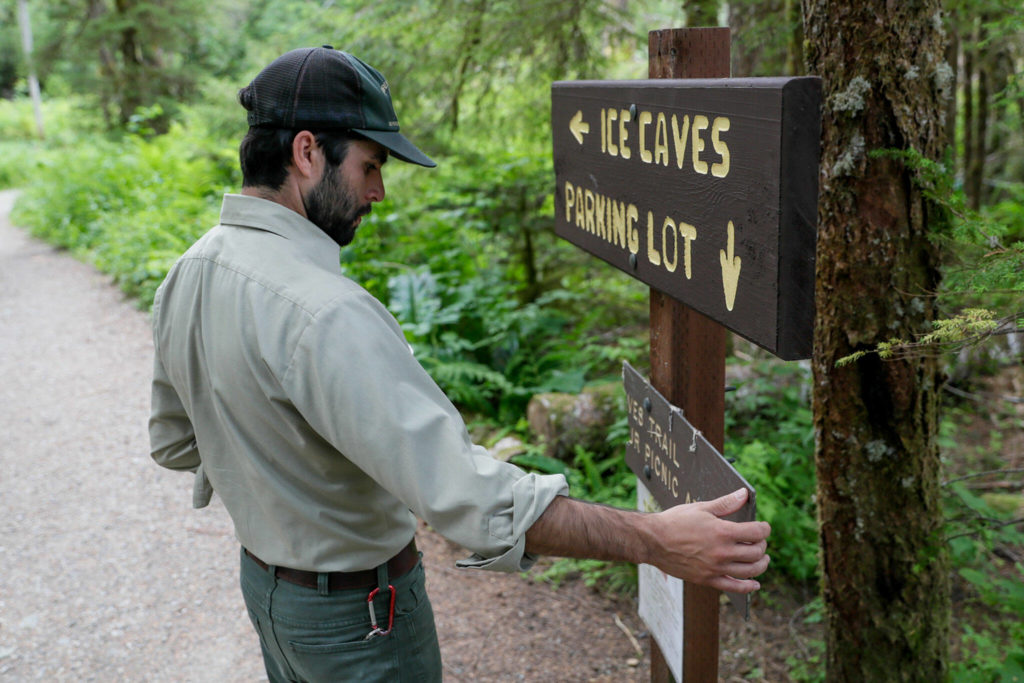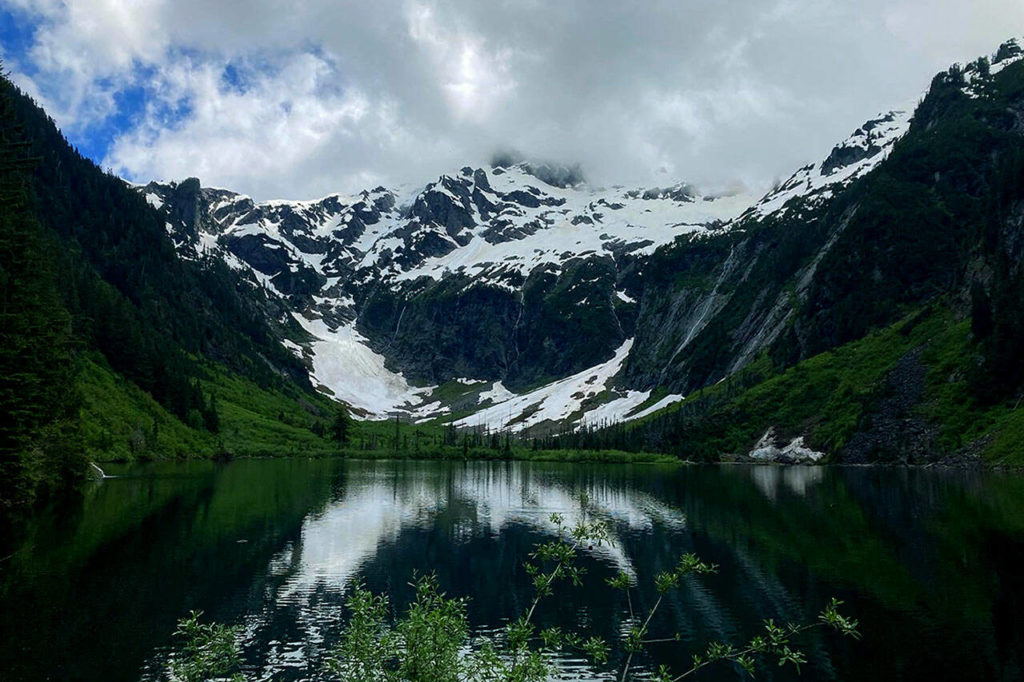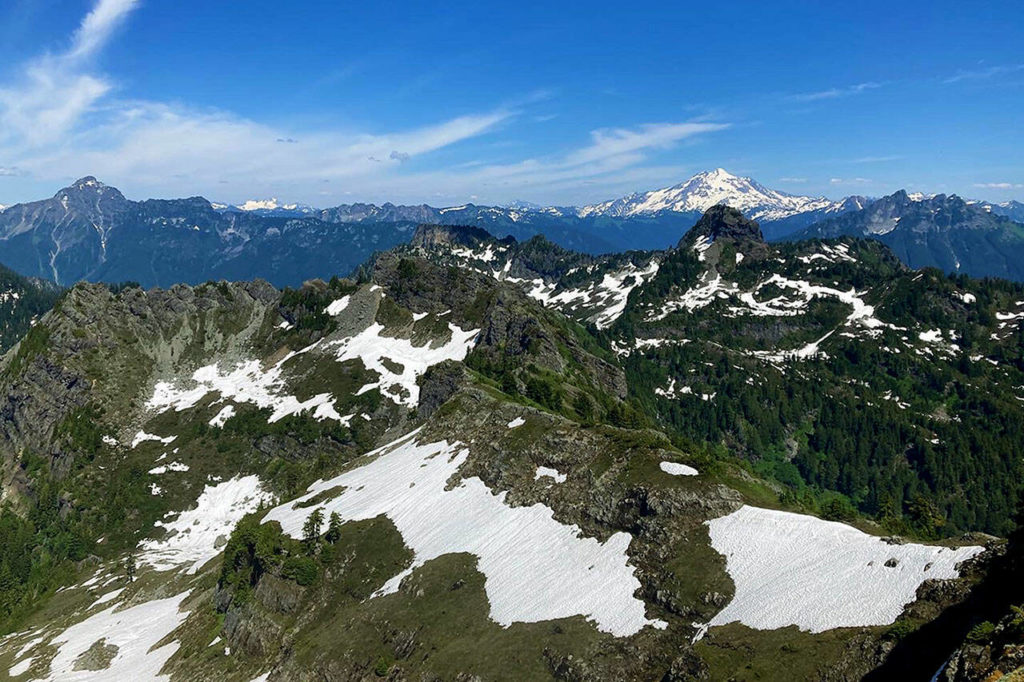VERLOT — “Rookie mistake,” Justin Sundstrom chuckled to himself as he piloted his work pickup through the woods, dipping up and down in 6-foot-wide potholes.
The U.S. Forest Service ranger left the lid of his Yeti tumbler open when he drove up the road off Mountain Loop Highway that leads to the trailheads for Heather Lake and Mount Pilchuck. Coffee splashed onto his olive-green pants. The bumpy backroad, notorious for potholes and puddles, serves as one of the many gateways to beloved hikes and views in Snohomish County.
“On some of our roads, it’s not uncommon to see pieces of a car, like a bumper or something,” Sundstrom said. “Because they’ve just bottomed out. So I like people to do a little bit of trip planning and just give us a call to see what the conditions are before heading out.”
To get a look at a day in the life of one of the five full-time forest rangers who oversee the Verlot corridor of Mountain Loop Highway, a reporter from The Daily Herald rode shotgun with Sundstrom for a day.
Sundstrom, 36, started his Saturday shift at the Verlot Public Service Center. Hot coffee in hand, he hit the road in a white Forest Service truck.
The first stop of the day was Forest Service Road 41. The winding road leads to the trailhead for the historic Three Fingers Lookout. Getting to the 90-year-old fire lookout built on a dynamited slab of basalt is not for the faint of heart, and those who embark on the treacherous climb first have to walk or mountain bike up a washed-out road. Upon reaching the actual trail, climbers meander a couple miles to the meadows of Goat Flats, then up to Tin Can Gap, along the ridge, over some rocks, across a glacier and through a snowfield.
Toward the top, a series of vertical ladders precedes the precariously perched hut that towers nearly 7,000 feet in the sky. Crampons, an ice ax and climbing experience are all but required.
‘Target practice’
Forest rangers rarely drive up Road 41 anymore.
“It’s unsafe for us to be up here,” Sundstrom said, “because of all of the shooting. Just the recreational shooting people do out here, they don’t do it in a responsible way. You know, following the regulations.”
As the ranger drove, gunfire echoed across the rocky hillside and groups of people could be seen on the side of the road, firing pistols and shotguns.
“A lot of our ‘No Shooting’ signs make great target practice for people,” he said.
It is legal for people to recreationally shoot on stretches of Road 41, as long as they follow the laws. You need a proper backstop. Sundstrom gestured to an open area popular for shooting.
“You don’t want to be shooting in an area like that where there could be other people around,” the ranger said. “You don’t want to be shooting at live trees.”
If he sees somebody shooting illegally on Forest Service land, Sundstrom said he typically won’t approach unless they are in a crowded area. Rangers leave that up to Snohomish County sheriff’s deputies.
“I’m not a law enforcement officer,” he said. “I don’t carry a gun. I haven’t been trained in that. I am a forest protection officer. So there are rules and regulations that I can educate, and if needed, write people a citation.”
Some of Road 41 is private property. Other sections are state-owned or part of the Mt. Baker-Snoqualmie National Forest.
“This clear-cutting you see over here, that’s not Forest Service land,” Sundstrom said. “People might think that and they show up and ask, ‘Why’d you guys cut all of that?’ And it’s not our property.”
The Forest Service does have some active timber sales in the Verlot corridor, however, Sundstrom said.
“I’m not in timber, so I don’t know all the details and facts about it,” he said. “But what I do know is that where they are logging, it’s thinning out. So they’re not clear-cutting. And it’s in areas that have been logged before, so they’re not going into a new area and logging that.”
Thinning of trees can help forest and vegetation health, the ranger said. Sometimes, it can aid in mixing plant species, so as to not have one dominant type of tree.
“There are a lot of studies,” he said. “We don’t just say, ‘We’re going to cut all these trees here.’ There’s a lot of prep work that goes into it.”
‘A full day’s work’
One sad reality about the life of a ranger: The Verlot crew devotes entire days to picking up trash.
“You just want to make sure you’re following the leave-no-trace principles,” Sundstrom said. “Pack it in, pack it out.”
Yet a lot of people don’t. Food waste, camping gear and cans are often left behind, strewn about abandoned campsites. Cars, refrigerators and couches get dumped illegally along the Mountain Loop. The Forest Service has an agreement with a Snohomish County environmental cleanup team for the big litter.
“Their response time is really good,” he said. “They usually come out within a few days to clean up the site for us.”
Local volunteers sometimes trudge through the forest to pick up shell casings and Miller High Life cans.
“Last year,” Sundstrom said, “there was a big group up here that was cleaning up some of the areas where people commonly go to shoot.”
Sundstrom swung by the Big Four Ice Caves trailhead next. He explained work is being done to repair the footbridge that crosses the South Fork Stillaguamish River and leads to an icy mountainside carved out by an avalanche chute and millions of years of shifting tectonic plates. The aluminum bridge went out in 2019. As the ranger walked along the path, he noticed a piece of wooden boardwalk leading up to the broken bridge had fallen off. Over by the trailhead parking lot, Sundstrom made mental note of spots where brush needs to be cut back so signs are visible.
“I’m realizing we have a full day’s work to do here, just at this one site” he said. “If we didn’t have to focus so much on the litter pickup and the dispersed sites, then we’d have more time for these projects. Trying to keep team morale up can sometimes be a challenge.”
At the Big Four picnic area, the marshland had a past life near a bustling railroad hotel.
The Big Four Inn was built in 1921 to increase tourism on the Monte Cristo Railway. One busy season, more than 6,000 visitors slept in the fancy, 35-room inn.
In September of 1949, the inn burned to the ground. All that remains of it today is the lobby’s large stone fireplace.
“I like it better how it is now,” Sundstrom said.
Today, the Big Four picnic area has an ADA-accessible trail — a unique thing in the heart of the Cascades.
The ice caves themselves are both popular and dangerous. Four people have died from falling snow and ice since the late 1990s. Several others have been injured. Warning signs and memorials remind people that melting, unstable ice can kill.
But the caves aren’t the only attraction. Considered one of the best birding areas in the North Cascades, visitors to Big Four include red-breasted sapsuckers and spotted sandpipers. Someone munching a peanut butter and jelly sandwich at the picnic area may be graced with the familiar call of a red-winged blackbird. Sundstrom saw a beaver there once.
“I look for that beaver every time I come back,” he laughed.
‘A fed bear is a dead bear’
Sundstrom urged hikers to properly prepare before heading out for an adventure on the Mountain Loop. Pack your 10 essentials, including food, water and sun protection. Research trail and road conditions. Always have a plan B and plan C in case a trailhead parking lot is full or your destination isn’t accessible due to snow, high rivers or other wildcards.
“It’s often people come out here from Seattle or Everett and assume the weather will be the same,” he said. “It could be sunny in Seattle and pouring rain up here.”
If you have questions about visiting trails on the Mountain Loop, the service center website has useful information. And those who can’t find answers online are encouraged to call the Verlot station.
“We’re here to help,” he said.
Cell phone reception here ranges from shoddy to nonexistent. To avoid getting lost, buy a map at the Verlot station.
In the event of an emergency, a pay phone exists at the Verlot station. Many 911 calls, including those reporting deadly collapses at the ice caves, have come from the pay phone at the Verlot Public Service Center. People have used the Verlot phone more than 100 times for emergencies since 2016.
The U.S. Forest Service announced Friday that this year has seen an uptick of bear sightings at campgrounds, picnic areas and trails in the Mount Baker-Snoqualmie National Forest.
“It may be tempting to offer food to bears that seem to be unafraid of people,” the announcement reads, “but this is never a good idea.”
“A fed bear is a dead bear!” Forest Service officials wrote.
Bears who are fed by people will return to those camps in search of food. Sometimes bears who return are euthanized if they create concerns over human safety, according to the announcement.
Often black bears are more interested in berries than human observers. The state Department of Fish and Wildlife has documented only one fatal black bear encounter in Washington’s history, and just over a dozen cases where a bear injured a person. Almost all of those involved hunters who shot a bear, or a dog who chased a bear.
Still, bears are big wild animals. So make sure your grub is secured in a bear can, bear box or hung up in a tree. Raccoons, mice and other wildlife also search for their next meal in human camping areas.
If you encounter a bear, here are some tips:
• Never run. Running can encourage the bear to chase you.
• Remain calm, pick up small children, restrain pets and be careful not to startle the bear.
• Let the bear know you are human by talking to it softly and calmly.
• Continue to face the bear while backing away slowly and watching for changes in behavior.
• Carry bear spray.
‘Preserve and protect’
Asked what his favorite hike on the Loop is, Sundstrom laughed: “I get that question a lot.”
It depends on the time of year, the conditions and the mood.
“Maybe it’s a good time for wildflowers,” he said. “That may be my favorite at that point in time.”
A couple weeks ago, Sundstrom wanted to relax so he hiked to Goat Lake and set up a hammock in the trees by the water. The 10½-mile loop trail is a relatively flat journey through dense mossy forest, past creeks and waterfalls.
Sundstrom also likes to climb mountains off the loop, such as Vesper Peak and Mount Dickerman.
For energy on the trail, one of his go-tos is tortilla wraps stuffed with turkey, spinach, cranberries and cream cheese. His other favorite is dinner from the night before.
“Whatever that might be,” he said. “Not, like, a specific meal, but definitely leftovers. Whether it was like a pasta dish, or hamburgers, or whatever.”
Sundstrom grew up in the Central Valley of California. He has always lived his life outside, he said. Growing up, his main pastime was skateboarding. He began his career as a steward of public lands about a decade ago, doing seasonal work in Sequoia and Kings Canyon national parks.
In 2016, he found his home and job with the Darrington Ranger District, where rangers are tasked with a delicate balance of keeping the Mountain Loop accessible while preserving its natural state.
“I think most people who work for the Forest Service share a common interest,” he said. “I think they all have respect for the land and enjoy being outdoors. We want to preserve and protect our public lands. Educating the public is rewarding.”
According to a survey, the popular Lake 22 hike off the loop sees about 50,000 hikers per year, while Heather Lake, another fan favorite, sees roughly 30,000. The high foot traffic keeps Sundstrom and the Verlot rangers busy with projects and trail maintenance.
“We are a small crew who does a lot of work,” he said. “We do the best we can. But obviously we’re not getting to all of it. We’re constantly busy.”
Asked what his favorite spot on the loop is, Sundstrom said he can’t give up his good ones.
He said, “There’s some places you’ve just got to keep a secret.”
Ellen Dennis: 425-339-3486; ellen.dennis@heraldnet.com; Twitter: @reporterellen.
Talk to us
> Give us your news tips.
> Send us a letter to the editor.
> More Herald contact information.


